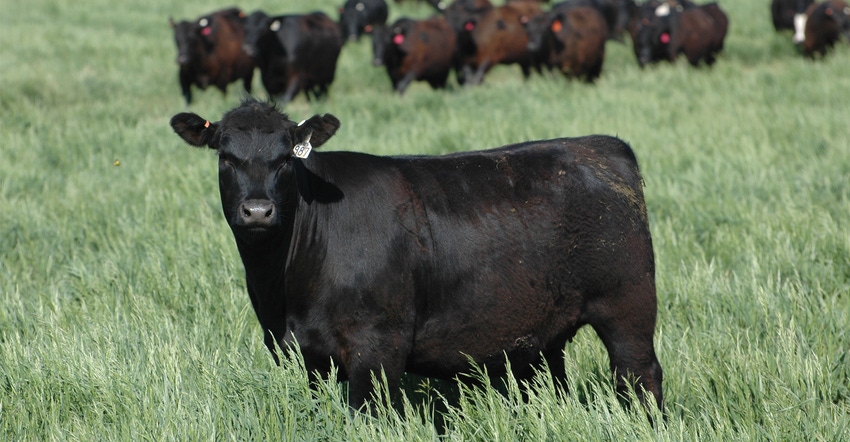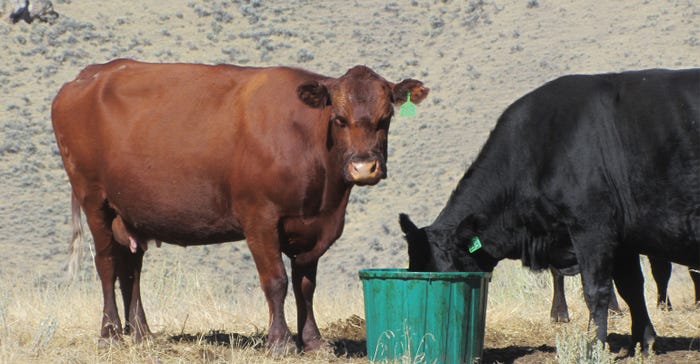Year-round grazing? Yes, it's possible!
Managing for year-round grazing can help cut costs.
March 9, 2020

Winter feeding is generally the biggest cost for cattle producers, so the goal is to reduce the number of days you put feed in front of your cattle. With well-planned forage management, cattle can harvest their own feed year-round, especially in mild climates. Even in Northern climates with cold weather and snow, this can work in certain situations, with a backup plan when winter storms make grazing impossible.
There are basically four sources of forage: native pasture; seeded perennials (alfalfa, grass, etc.), annuals for grazing (oats, barley, spring and winter cereals, corn, cocktail cover crop mixtures, etc.), and annual crop residues, says Lorne Klein, range management Extension specialist, Saskatchewan Ministry of Agriculture.
Fall and winter grazing is used more today than in the past. “Four things changed. One was electric fence. It existed earlier, but usually in permanent locations; no one used portable fences. Second was portable windbreaks. Now we can put cattle nearly anywhere and give them a windbreak.”
Third is snow as a water source, he says. “Years ago, some people relied on snow, but today, more people realize it can be done. We can winter livestock nearly anywhere if there’s adequate snow for a water source. If you don’t get snow, you need a back-up plan for water.”
Fourth is summer calving. “As ranchers get older, they may consider this because early calving is so labor-intensive,” Klein says.
Annual forages
There are many annuals used today; some are being “reinvented,” and there are also new varieties. “Some cool-season cereals and many warm-season crops are now utilized by cattle for grazing at different times of year,” Klein says.
For instance, fall rye can be stockpiled for winter. “You can seed it in spring or summer, let it green up in the fall and graze it in winter. Italian ryegrass seeded in spring will green up again in the fall if it rains. Ryegrasses and corn are usually grazed standing,” he says.
Corn can be left standing for winter grazing. “Depending on maturity of kernels when it freezes and stops growing, there can be some risk of grain overload if you give cattle access to too much at once. If cobs are mature, and the cattle go through and eat the cobs first before they start on the stalks — they may suffer fatal grain overload.”
It’s best to strip-graze corn, allowing only a few days’ feed at a time, so they have to eat stalks before they leave that strip.
“The most common fall-winter grazing here has been swath grazing with annual cereals — oats, barley, millet, etc. Some cocktail cover crops like sugarbeets, collards, turnips, plantain, etc., can be grazed standing.
“There are many options now, but you need to check some of those for nitrates in certain conditions. Some cover crops get so green again in the fall that you need to strip-graze like you would alfalfa in summer, to avoid overeating and problems,” Klein says.
Most of the other annuals are generally windrowed and strip-grazed rather than giving cattle access to the whole field, or they will eat some of each windrow and waste more.
“It also depends on when you plan to graze; the amount of snow; and whether soil is frozen, dry or muddy,” Klein says. If it gets muddy, you may need to pull cattle out of that field and have a backup plan for how to feed them during that time.
“If a lot of snow drifts over the windrows, cattle may be unable to dig [them] out. I’ve seen fields so covered that you can’t tell there’s a windrowed crop. Experienced cows will root down and find the windrows, even if the snow is 2 feet deep,” he says.
If cattle haven’t done this before, put a few experienced individuals with them to show where the windrows are. Otherwise, they don’t realize there’s feed out there under the snow. Cattle learn from experience and from following the example of herd members.
Crop residues
Crop residues are probably the most underused source of winter grazing. “These include cornstalks, chaff piles, straw-bunch piles and straw rows. Crop with supplements can be a low-cost way to winter cattle,” Klein says.
Depending on the crop — whether lentils or wheat straw, sunflowers, etc. — you may not have to supplement, because some of these have high nutrient levels. It also depends on how cold it gets and your time of calving, Klein explains.
“For producers who can make crop residue work, it’s potentially the lowest-cost way to winter cattle. You already have the crop; and if the combine bunched it, you don’t need to make another trip over the field to put it in bunches or windrows for cattle to find in the snow,” he says.
The perfect marriage is someone with a cow herd next to a grain farmer willing to let cattle graze crop residue. “We almost never see this, however, unless there is a good relationship between the guy with 300 cows and the neighbor with 5,000 acres of crops beside him. Usually, the only time it’s done is when folks with a lot of cattle also farm a lot of land,” Klein says.
“Whether you put crop residue in rows behind the combine, or bunch it [to have a pile cows can get to if snow is deep] will depend on when you anticipate grazing. If it’s later in winter, you want it in bunches, but for early in the fall you can leave it in rows.”
Stockpiled perennial forages
“If you stockpile perennials, whether seeded or native, you give up quality grazing when they are mature. When grazing native range in late fall or in winter, meter it out with strip grazing to limit cattle to one portion at a time. Some people recommend three days at a time, others say seven days; figure out what works for your own situation,” Klein says.
“Cool-season grasses green up again in fall if there’s rain, and will be good quality and high in protein. A beef cow can recycle protein for up to five days to keep utilizing in the rumen [to feed the microbes that digest coarser roughages] and doesn’t need high-quality protein every day.”
If cattle are receiving a protein supplement, it can be fed every three to five days. Twice a week works nicely.
“That’s also what you are doing when you give them several days’ pasture at a time. They eat the best quality in that strip during the first day or two, then the next few days are eating the drier, lower-quality portions of the plants,” he explains.
“If you stockpile perennials for late-season grazing and don’t meter it out, for the first three weeks the cattle have good feed — and then it’s declining in quality, and you might need to supplement,” he says.
“There’s been a lot of discussion regarding cost of cutting and baling, but it’s also expensive to leave forage standing for cows to harvest, because you lose quality. Unless you meter it out to graze a couple days at a time, there’s significant trampling loss.”
If a good stand of seeded grass produces two or more big bales per acre, it may be beneficial to cut for hay. “With that kind of yield, it may be better to lock it up at optimum quality to feed in winter — with less waste and loss of quality,” Klein says.

Stockpiling grass during summer for winter grazing is not always best. “To get half the cow-days per acre and poorer-quality feed [than if it were put in a bale] isn’t best, unless it’s native pasture in terrain you can’t hay,” he says.
“There are many variables in this decision, however. It depends on how far away from home it is and how far you have to haul bales, or whether there’s a road,” he says.
“Every time we make a statement about what works best or is more profitable, there’s a scenario where it doesn’t work at all.”
You might have pastures where stockpiling is the best use, and this may change from year to year. One fall you might have enough green regrowth that you don’t need to supplement for a while, and another fall you may need to supplement all the way through.
With native range or seeded pastures, you either graze in summer when they are good quality; or stockpile forage, let it decline in quality and then graze in winter. If you don’t have haying equipment, and terrain is more suited for grazing than haying, winter grazing might be most feasible — with a backup plan if you have to feed hay.
Smith Thomas is a rancher and freelance writer based in Salmon, Idaho.
About the Author(s)
You May Also Like


.png?width=300&auto=webp&quality=80&disable=upscale)
